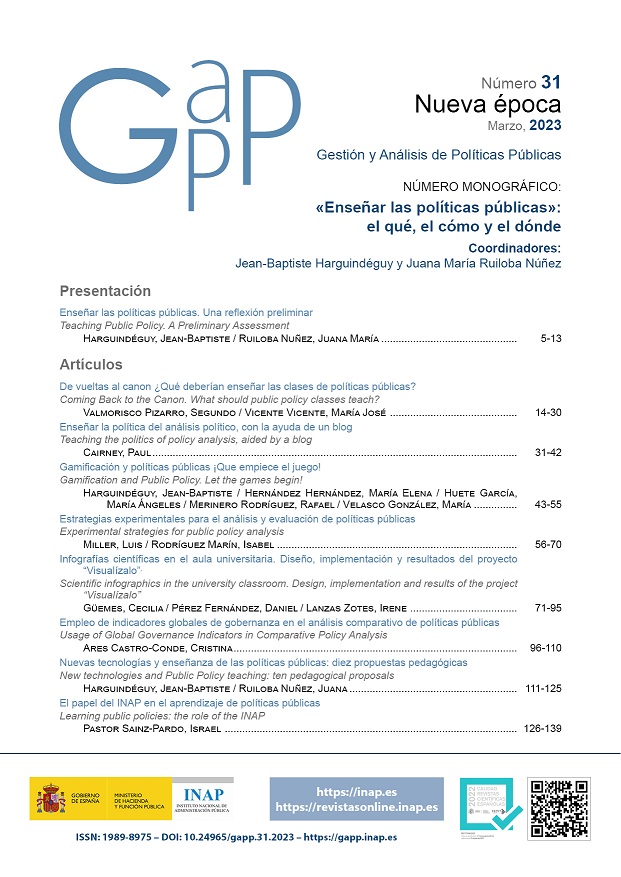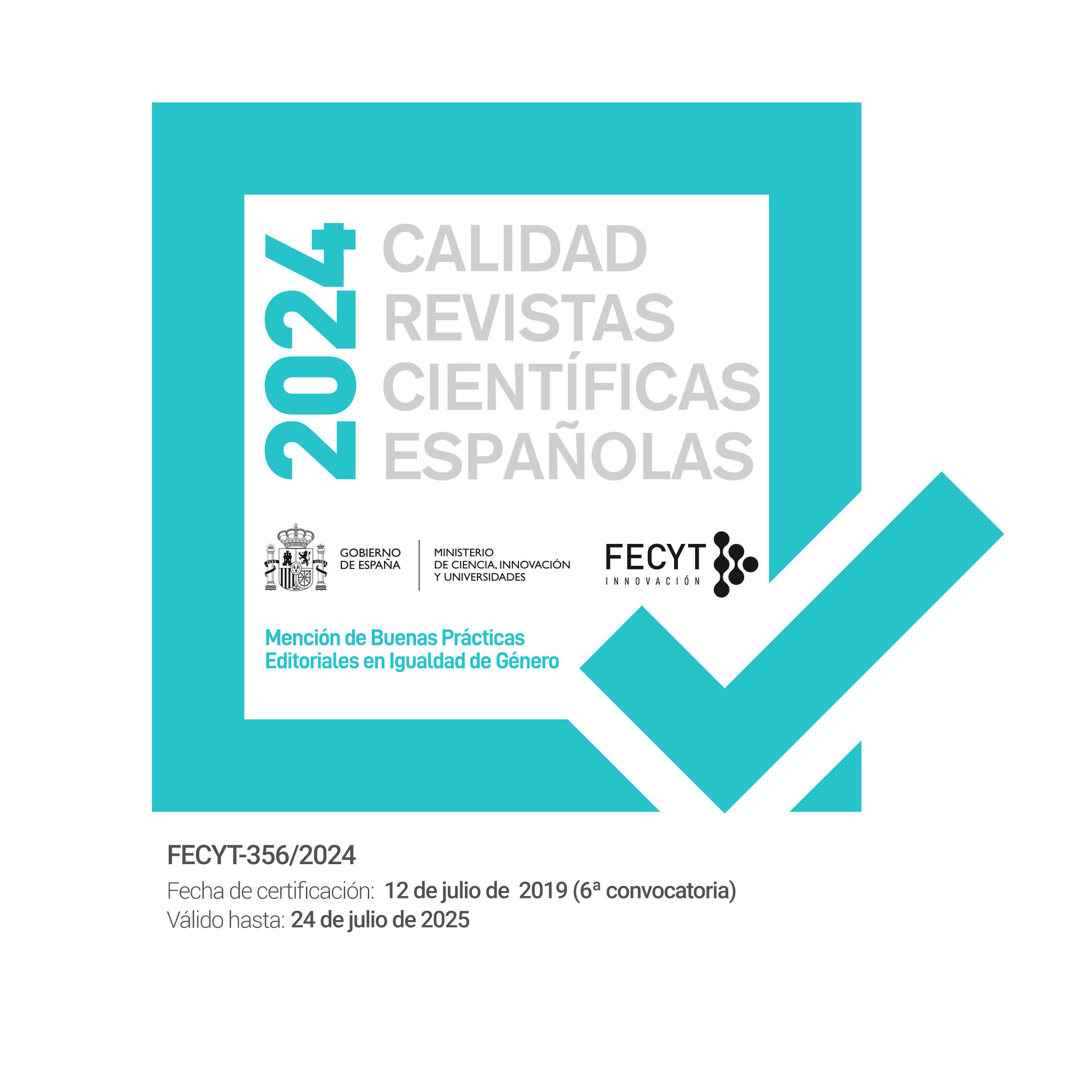Empleo de indicadores globales de gobernanza en el análisis comparativo de políticas públicas
DOI:
https://doi.org/10.24965/gapp.11113Palabras clave:
Capacidad para la elaboración de políticas, indicadores de gobernanza, Indicadores de Gobernanza Mundiales, indicadores de gobernanza para la acción, indicadores de segunda generación, índices globalesResumen
El objetivo de este artículo es compartir con nuevos usuarios de indicadores de gobernanza para el análisis comparativo de políticas públicas algunas fortalezas y debilidades de la construcción de estos datos, así como aspectos relevantes de su evolución en el tiempo, como la incorporación de los llamados «indicadores de segunda generación», que se centran en aspectos específicos de la gobernanza, sus efectos en el bienestar social, así como la transparencia del proceso de creación de estas evidencias y su reproducibilidad. Entre los desafíos de la producción y el empleo de indicadores globales de gobernanza se subrayan los relativos a la operacionalización de este concepto abstracto. Asimismo, el artículo anima a explotar de forma creativa los diversos indicadores de gobernanza disponibles en la actualidad, en ensayos, trabajos de consultoría e investigaciones en el campo del análisis de políticas en perspectiva comparada.
Descargas
Citas
Andrews, M. (2008). The Good Governance Agenda: Beyond Indicators without Theory. Oxford Development Studies, 36(4), 379-407. https://doi.org/10.1080/13600810802455120
Andrews, M., Hay, R. y Myers, J. (2010, abril). Governance Indicators Can Make Sense: Under-five Mortality Rates are an Example [HKS Faculty Research Working Paper Series RWP10-015]. Harvard Kennedy School. https://www.hks.harvard.edu/publications/governance-indicators-can-make-sense-under-five-mortality-rates-are-example
Anheier, H. K., Lang, M. y Knudsen, E. (2022). Toward a New Understanding of Governance: The 2022 Berggruen Governance Index. UCLA Luskin School of Public Affairs – Berggruen Institute. https://www.berggruen.org/work/the-planetary/the-2022-berggruen-governance-index/
Ares, C. (2022). Capacidad administrativa e implementación de la política de cohesión de la UE. Gestión y Análisis de Políticas Públicas, (29), 52-71. https://doi.org/10.24965/gapp.11061
Arndt, C. (2008). The Politics of Governance Ratings. International Public Management Journal, 11(3), 275-297. https://doi.org/10.1080/10967490802301278
Bradley, C. G. (2015). International Organizations and the Production of Indicators: The Case of Freedom House. En S. E. Merry, K. E. Davis y B. Kingsbury (eds.), The Quiet Power of Indicators. Measuring Governance, Corruption, and Rule of Law (pp. 27-74). Cambridge University Press.
Buduru, B. y Pal, L. A. (2010). The globalized state: Measuring and monitoring governance. European Journal of Cultural Studies, 13(4), 511-530. https://doi.org/10.1177/1367549410377144
Davis, K. E., Kingsbury, B. y Merry, S. E. (2012). Indicators as a Technology of Global Governance. Law & Society Review, 46(1), 71-104. https://doi.org/10.1111/j.1540-5893.2012.00473.x
Davis, K. E., Kingsbury, B. y Merry, S. E. (2015). Introduction: The Local-Global Life of Indicators: Law, Power, and Resistance. En S. E. Merry, K. E. Davis y B. Kingsbury (eds.), The Quiet Power of Indicators. Measuring Governance, Corruption, and Rule of Law (pp. 1-24). Cambridge University Press.
Erkkilä, T. (2020). Using indexes in comparative policy analysis: global comparisons. En B. G. Peters y G. Fontaine (eds.), Handbook of Research Methods and Applications in Comparative Policy Analysis (pp. 186-202). Edward Elgar Publishing.
Erkkilä, T. y Piironen, O. (2014). (De)politicizing good governance: the World Bank Institute, the OECD and the politics of governance indicators. Innovation. The European Journal of Social Science Research, 27(4), 344-360. https://doi.org/10.1080/13511610.2013.850020
Espeland, W. N. y Sauder, M. (2007). Rankings and Reactivity: How Public Measures Recreate Social Worlds. American Journal of Sociology, 113(1), 1-40. https://doi.org/10.1086/517897
Gisselquist, R. M. (2014). Developing and evaluating governance indexes: 10 questions. Policy Studies, 35(5), 513-531. https://doi.org/10.1080/01442872.2014.946484
Harguindéguy, J.-B. P., Cole, A. y Pasquier, R. (2021). The variety of decentralization indexes: A review of the literature. Regional & Federal Studies, 31(2), 185-208. https://doi.org/10.1080/13597566.2019.1566126
Hartley, K. y Zhang, J. (2018). Measuring Policy Capacity Through Governance Indices. En X. Wu, M. Howlett y M. Ramesh (eds.), Policy Capacity and Governance [Studies in the Political Economy of Public Policy] (pp. 67-97). Palgrave Macmillan. https://doi.org/10.1007/978-3-319-54675-9_4
Joshi, D. (2011). Good Governance, State Capacity, and the Millennium Development Goals. Perspectives on Global Development and Technology, 10(2), 339-360. https://doi.org/10.1163/156914911X582468
Kaufmann, D. y Kraay, A. (2007). Governance Indicators: Where Are We, Where Should We Be Going? [Policy Research Working Paper, 4370]. Banco Mundial. https://openknowledge.worldbank.org/handle/10986/7588
Kaufmann, D., Kraay, A. y Mastruzzi, M. (2010). The Worldwide Governance Indicators: Methodology and Analytical Issues [Policy Research Working Paper, 5430]. Banco Mundial. https://openknowledge.worldbank.org/handle/10986/3913
Knack, S., Kugler, M. y Manning, N. (2003). Second-generation governance indicators. International Review of Administrative Sciences, 69(3), 345-364. https://gsdrc.org/document-library/second-generation-governance-indicators/
Mahon, R. y McBride, S. (2009). Standardizing and disseminating knowledge: The role of the OECD in global governance. European Political Science Review, 1(1), 83-101. https://doi.org/10.1017/S1755773909000058
Nelken, D. (2015). Conclusion: Contesting Global Indicators. En S. Merry, K. Davis y B. Kingsbury (eds.), The Quiet Power of Indicators. Measuring Governance, Corruption, and Rule of Law (pp. 317-338). Cambridge University Press.
Raub, A., Sprague, A., Waisath, W., Nandi, A., Atabay, E., Vincent, I., Moreno, G., Earle, A., Perry, N. y Heymann, J. (2022). Utilizing a Comparative Policy Resource from the WORLD Policy Analysis Center Covering Constitutional Rights, Laws, and Policies across 193 Countries for Outcome Analysis, Monitoring, and Accountability. Journal of Comparative Policy Analysis: Research and Practice, 24(4), 313-328. https://doi.org/10.1080/13876988.2021.1894073
Sartori, G. (1970). Concept Misformation in Comparative Politics. American Political Science Review, 64(4), 1033-1053. https://doi.org/10.2307/1958356
Shubham, S., Shi, L. y Wu, X. (2021). The Policy Capacity of Bureacracy. En W. R. Thompson (ed.), Oxford Research Encyclopedias, Politics. Oxford University Press. https://doi.org/10.1093/acrefore/9780190228637.013.1399
Thomas, M. A. (2010). What Do the Worldwide Governance Indicators Measure? European Journal of Development Research, (22), 31-54. https://doi.org/10.1057/ejdr.2009.32
Trapnell, S. E. (2011). Actionable Governance Indicators: Turning Measurement into Reform. Hague Journal on the Rule of Law, 3(2), 317-348. https://doi.org/10.1017/S1876404511200095
Wu, X., Ramesh, M. y Howlett, M. (2015). Policy capacity: A conceptual framework for understanding policy competences and capabilities. Policy and Society, 34(3-4), 165-171. https://doi.org/10.1016/j.polsoc.2015.09.001
Zanotti, L. (2005). Governmentalizing the Post-Cold War International Regime: The UN Debate on Democratization and Good Governance. Alternatives, 30(4), 461-487. https://doi.org/10.1177/030437540503000404
Descargas
Publicado
Cómo citar
Número
Sección
Licencia
Derechos de autor 2022 Gestión y Análisis de Políticas Públicas

Esta obra está bajo una licencia internacional Creative Commons Atribución-NoComercial 4.0.












